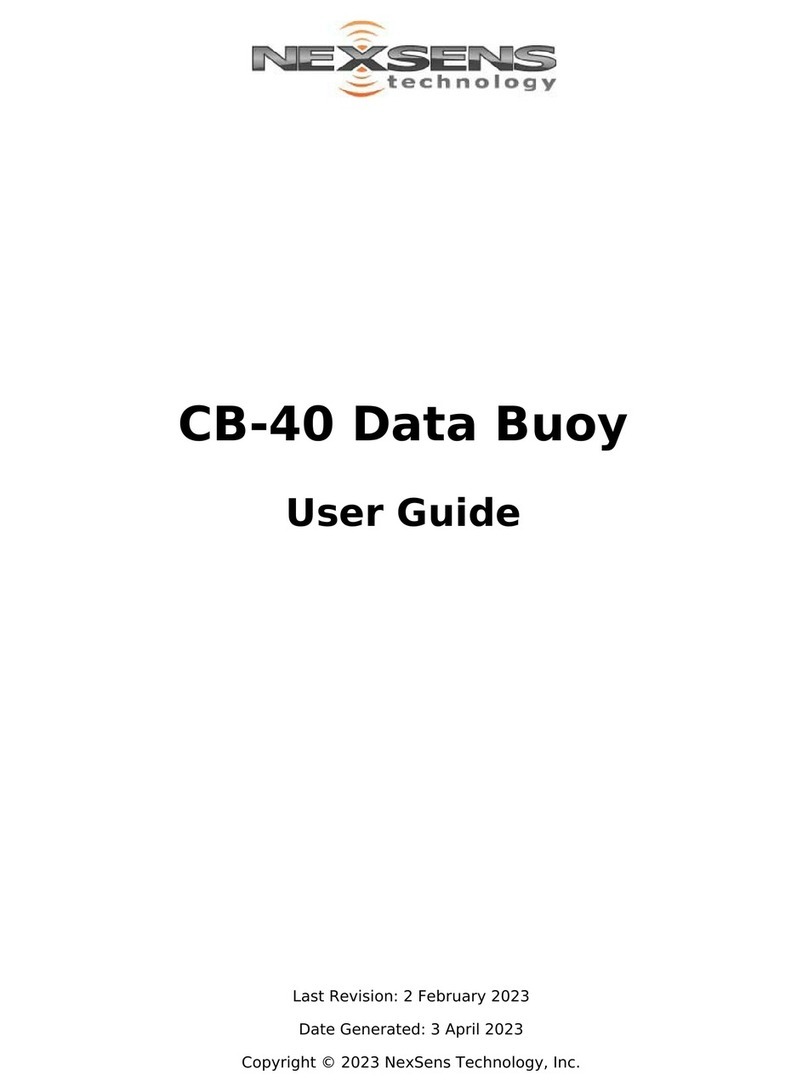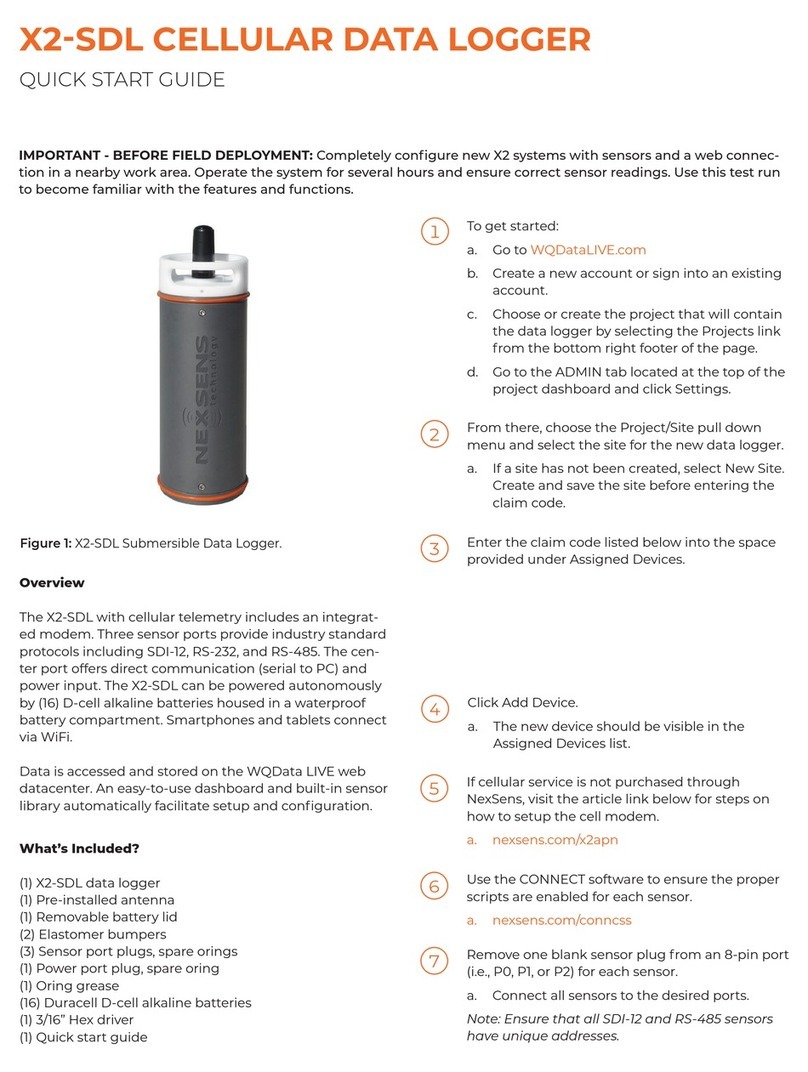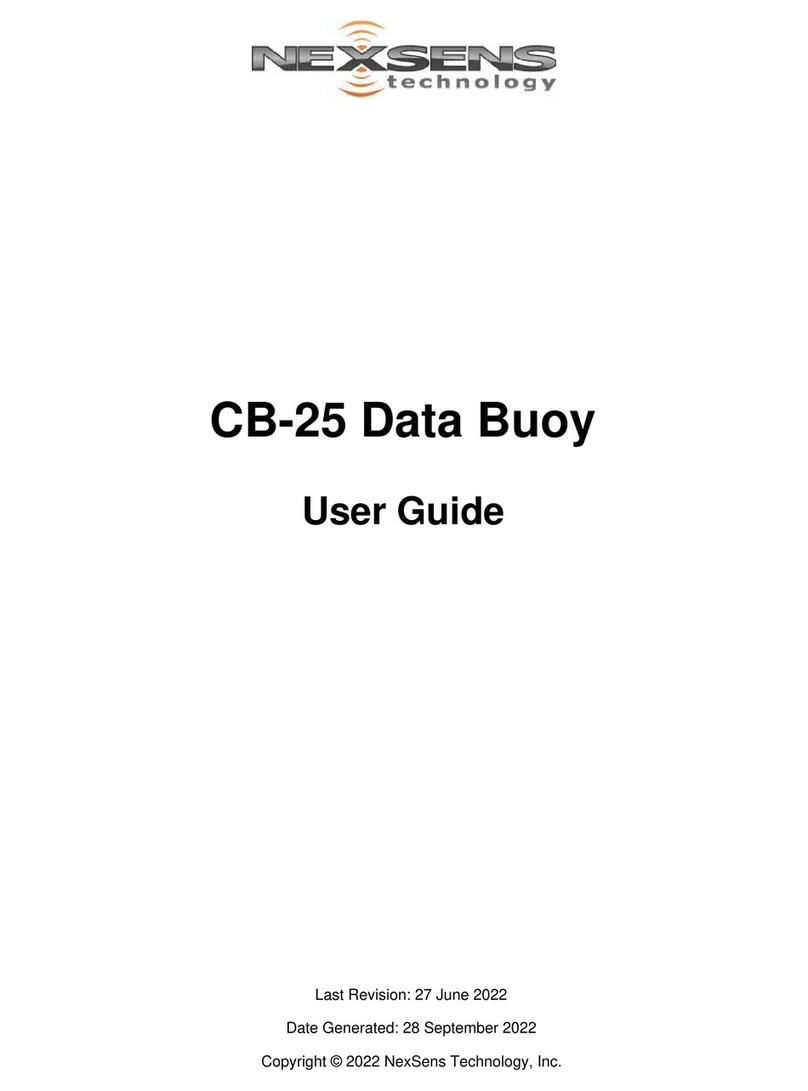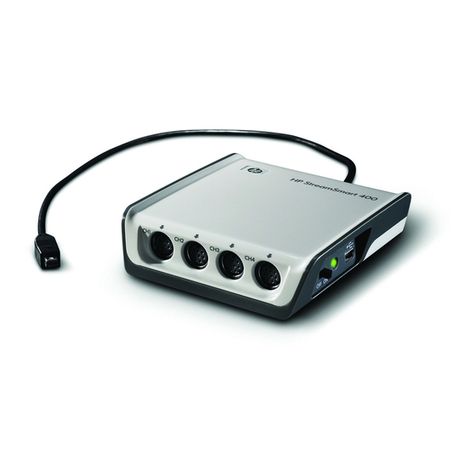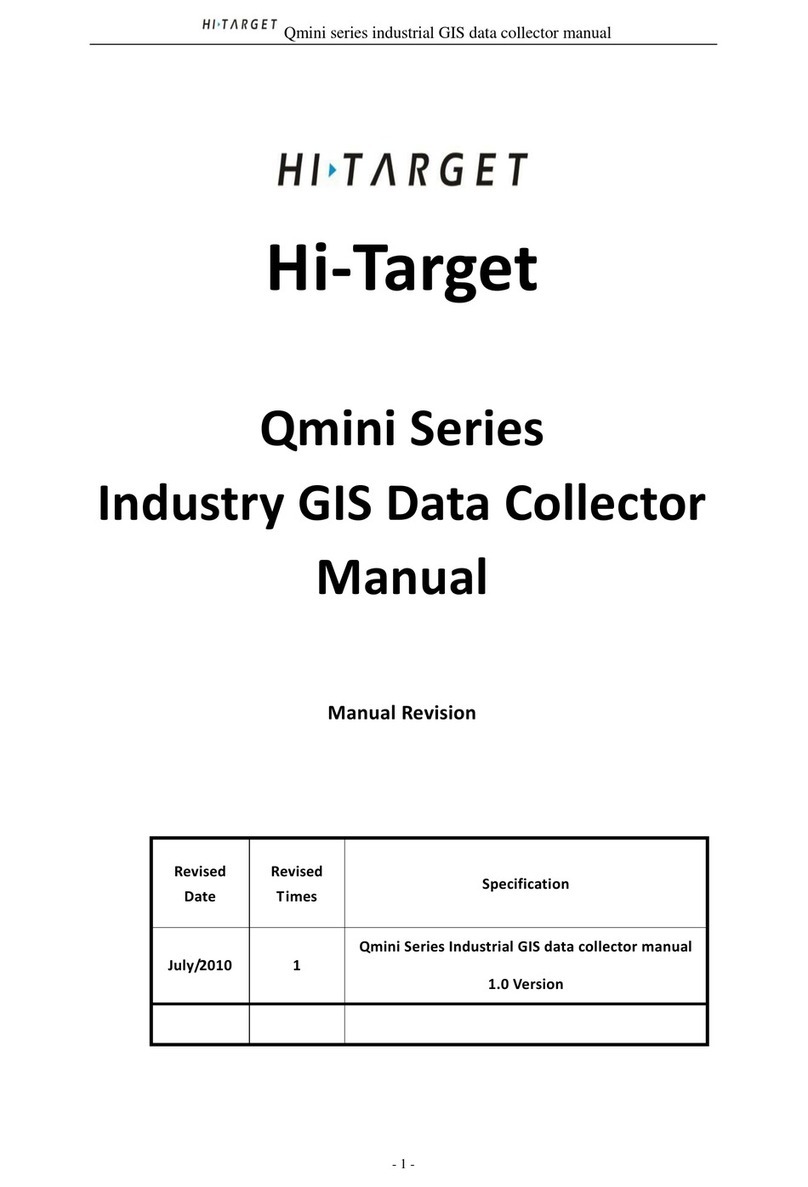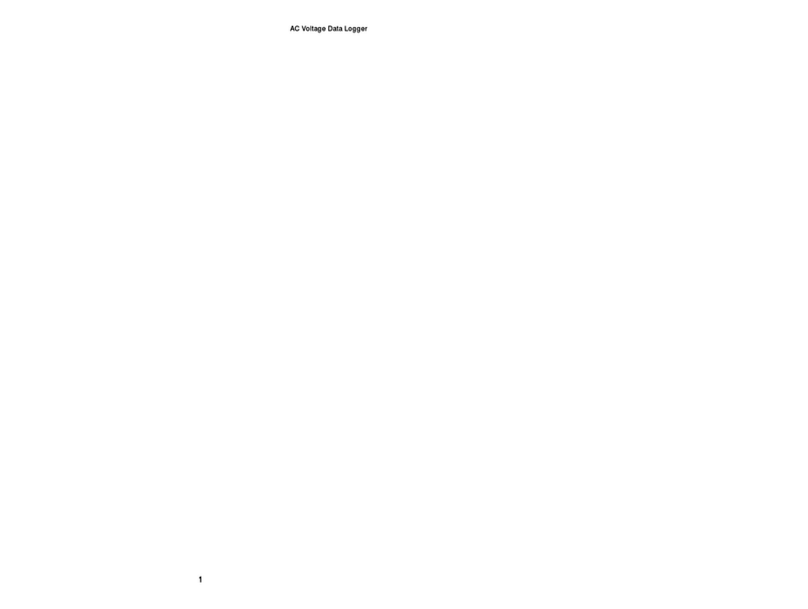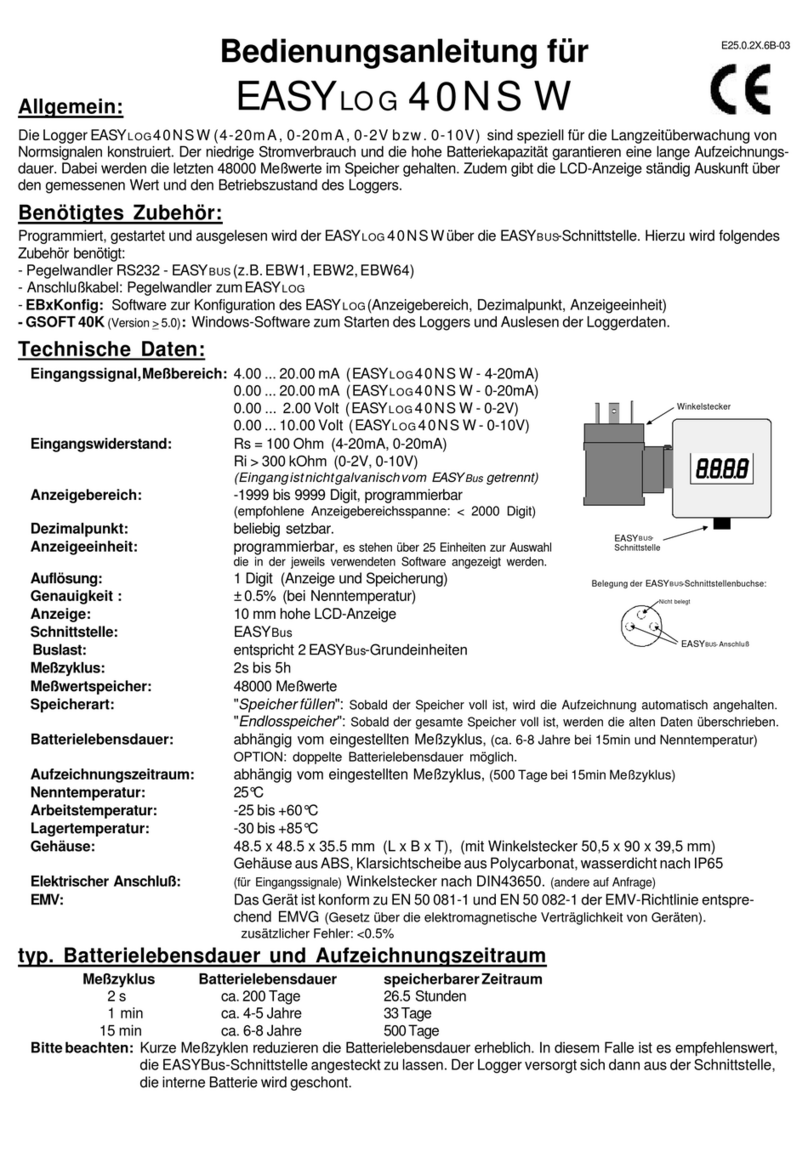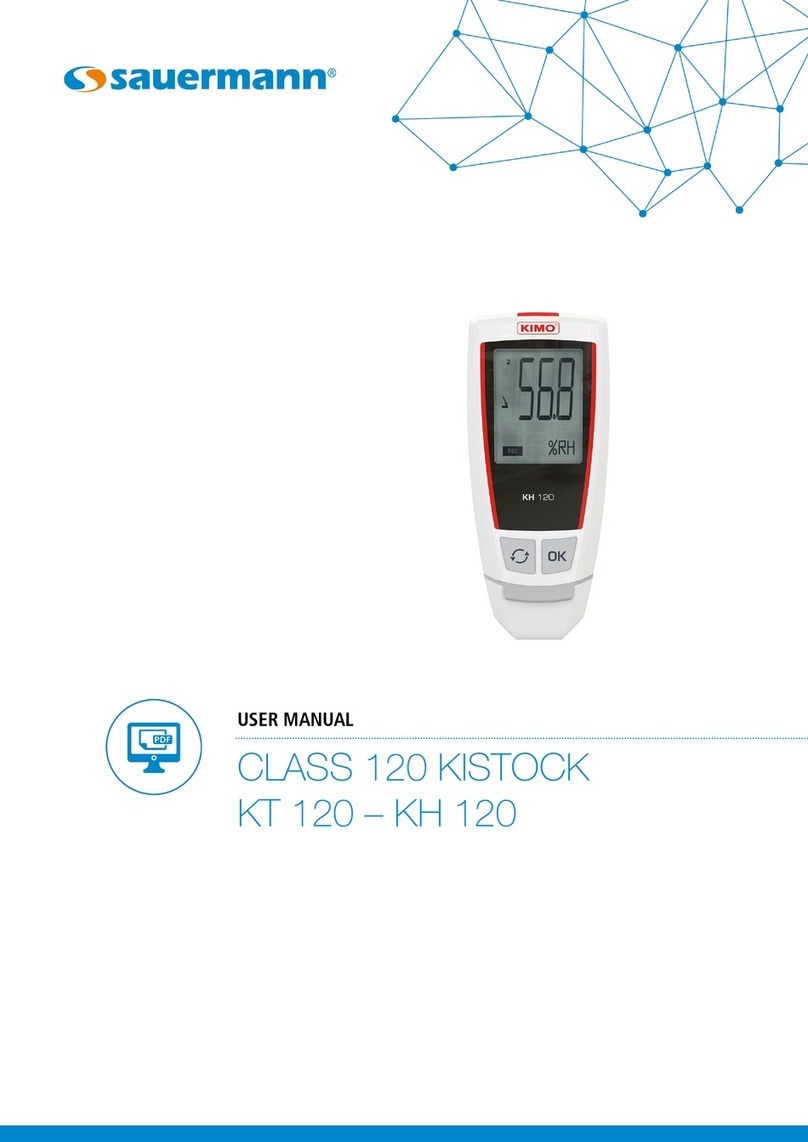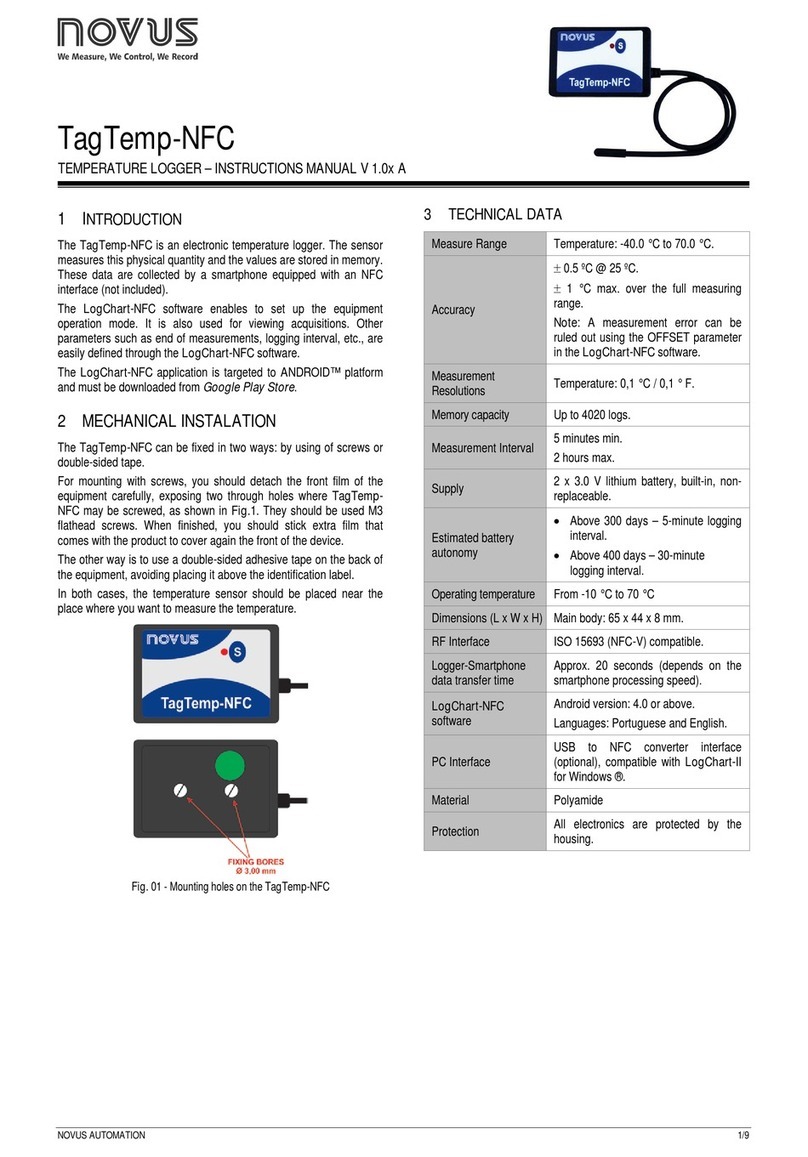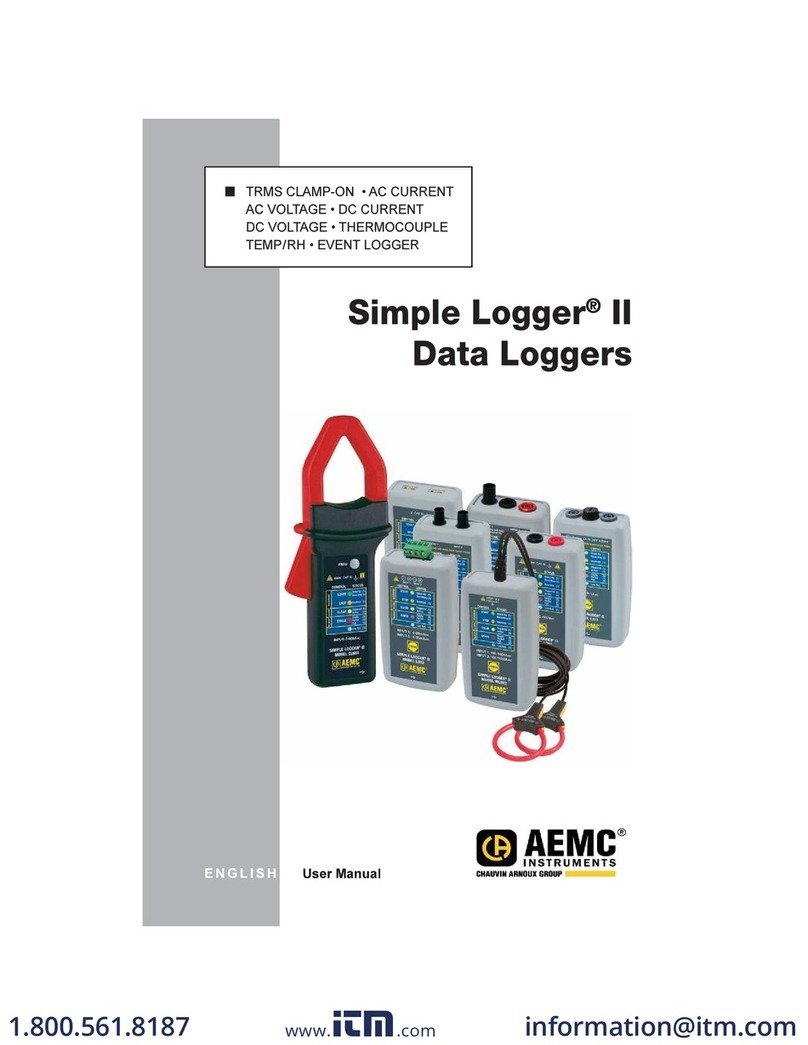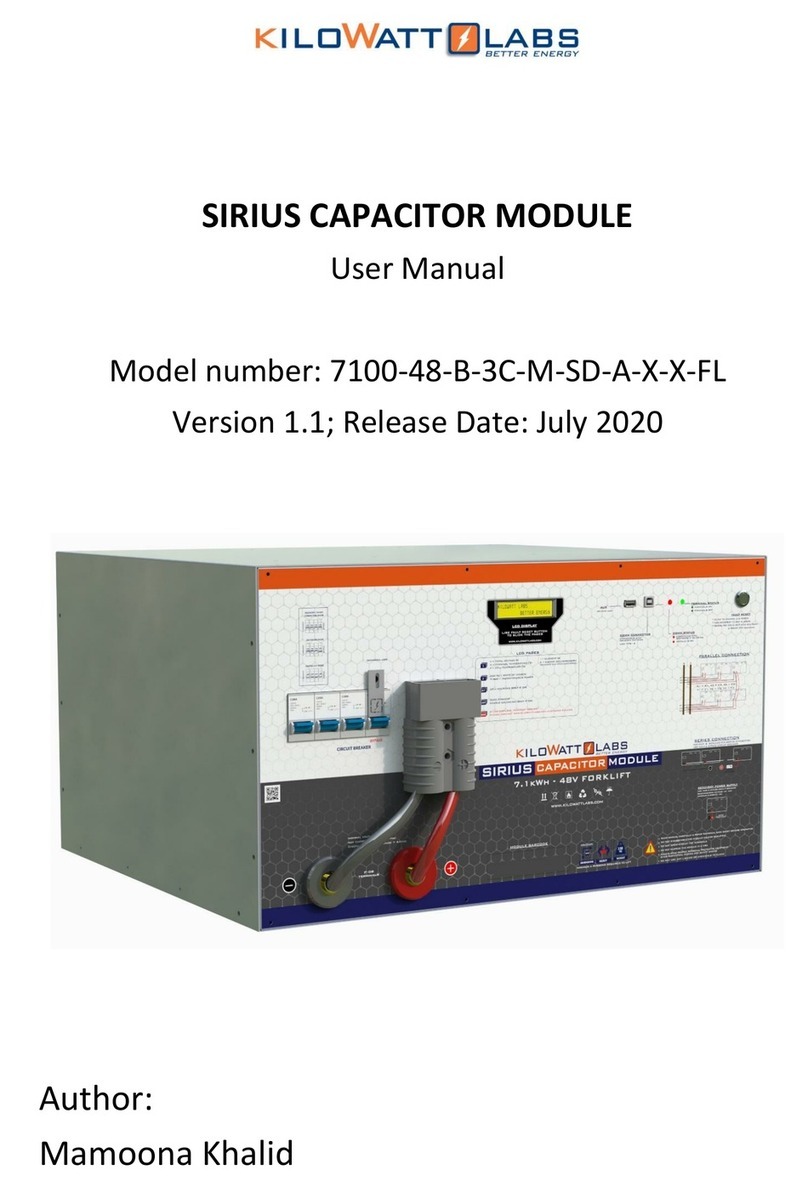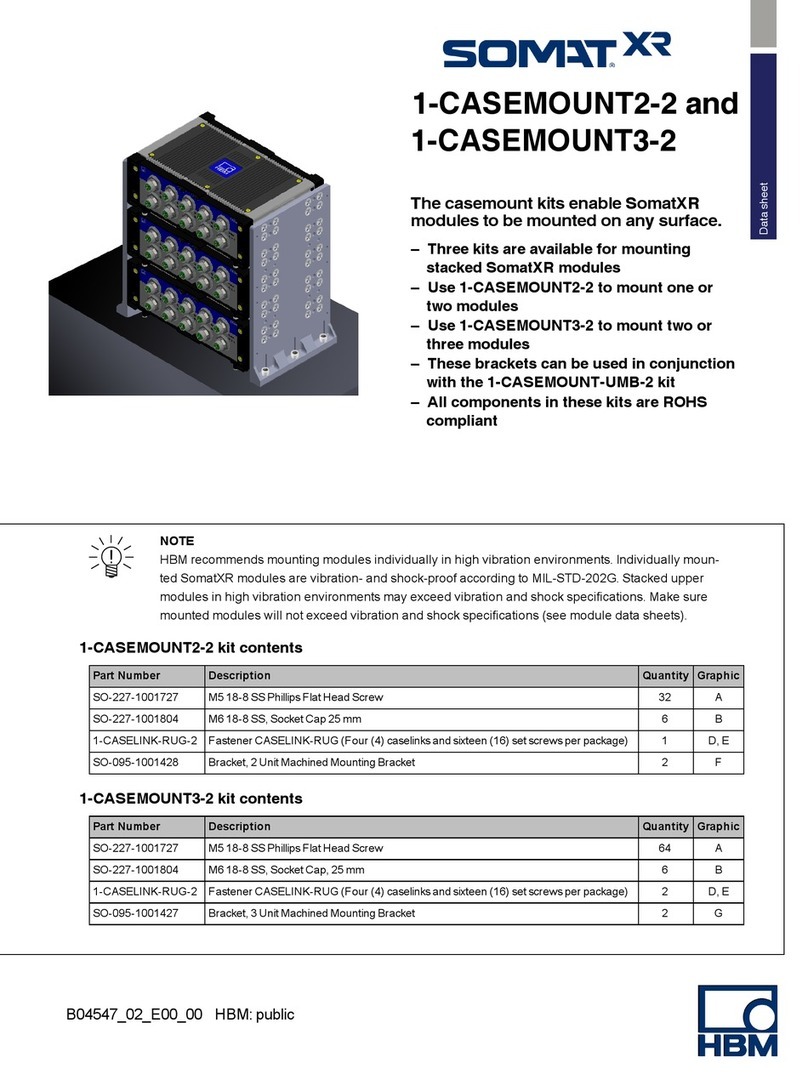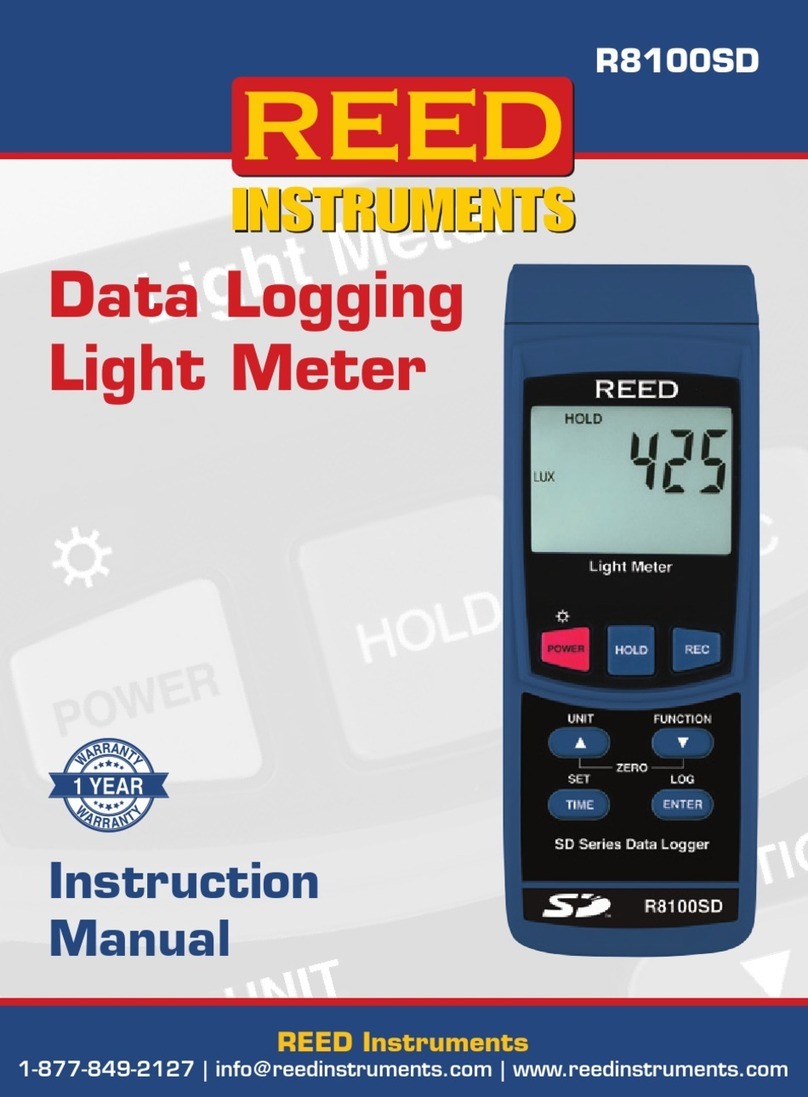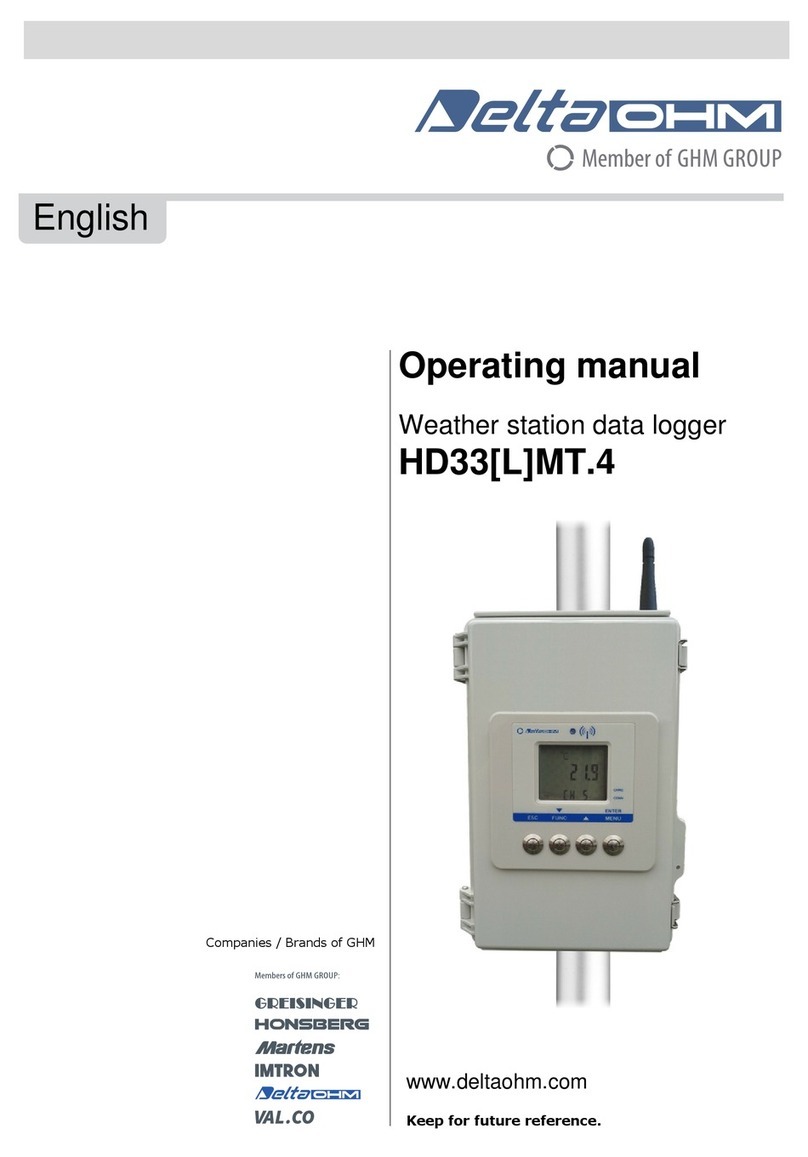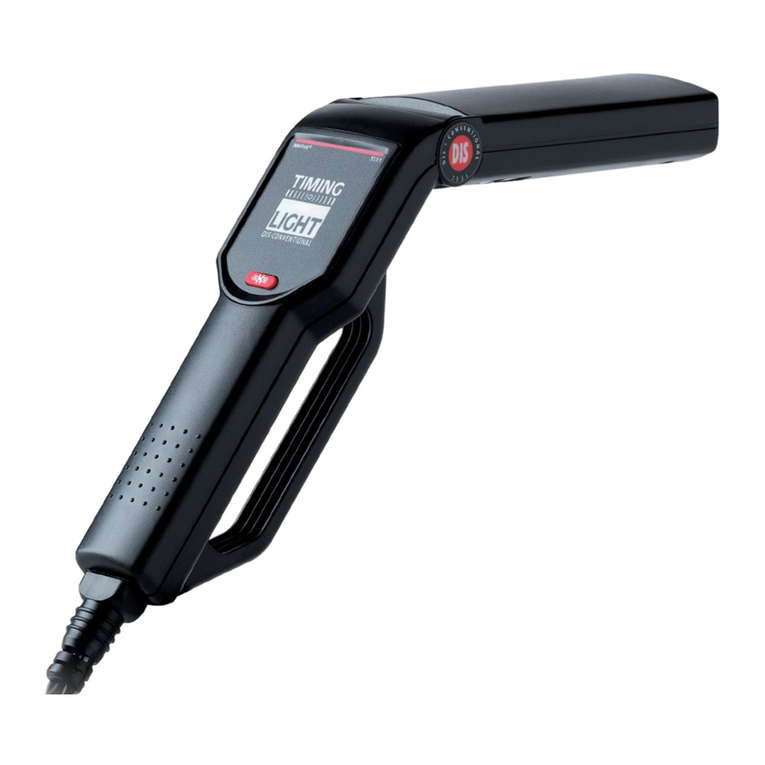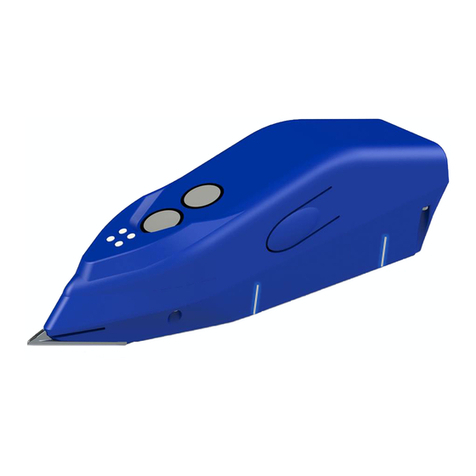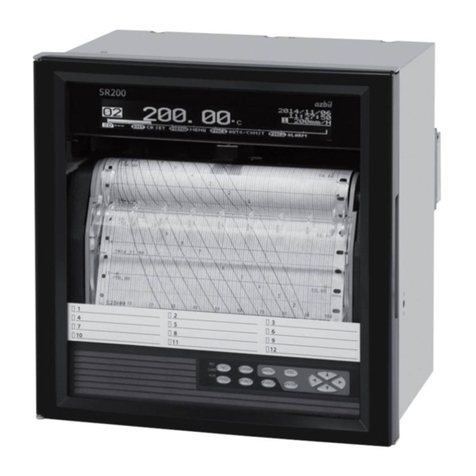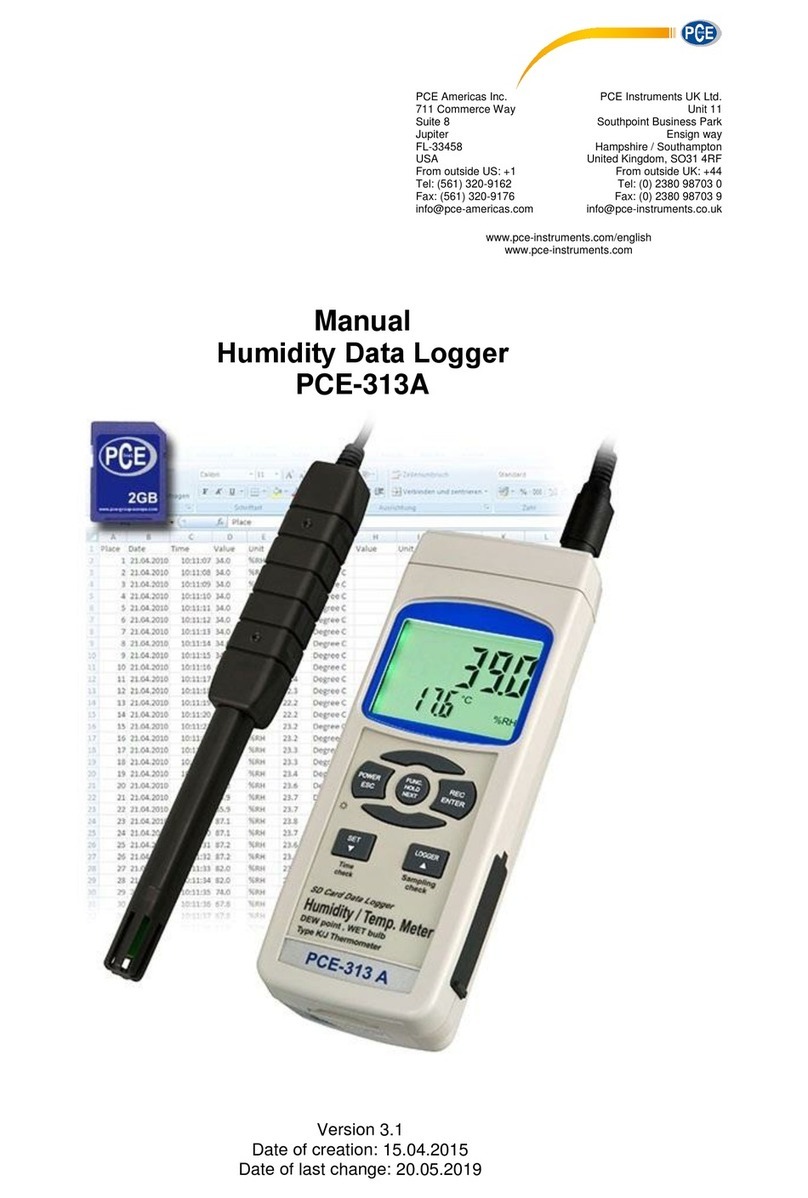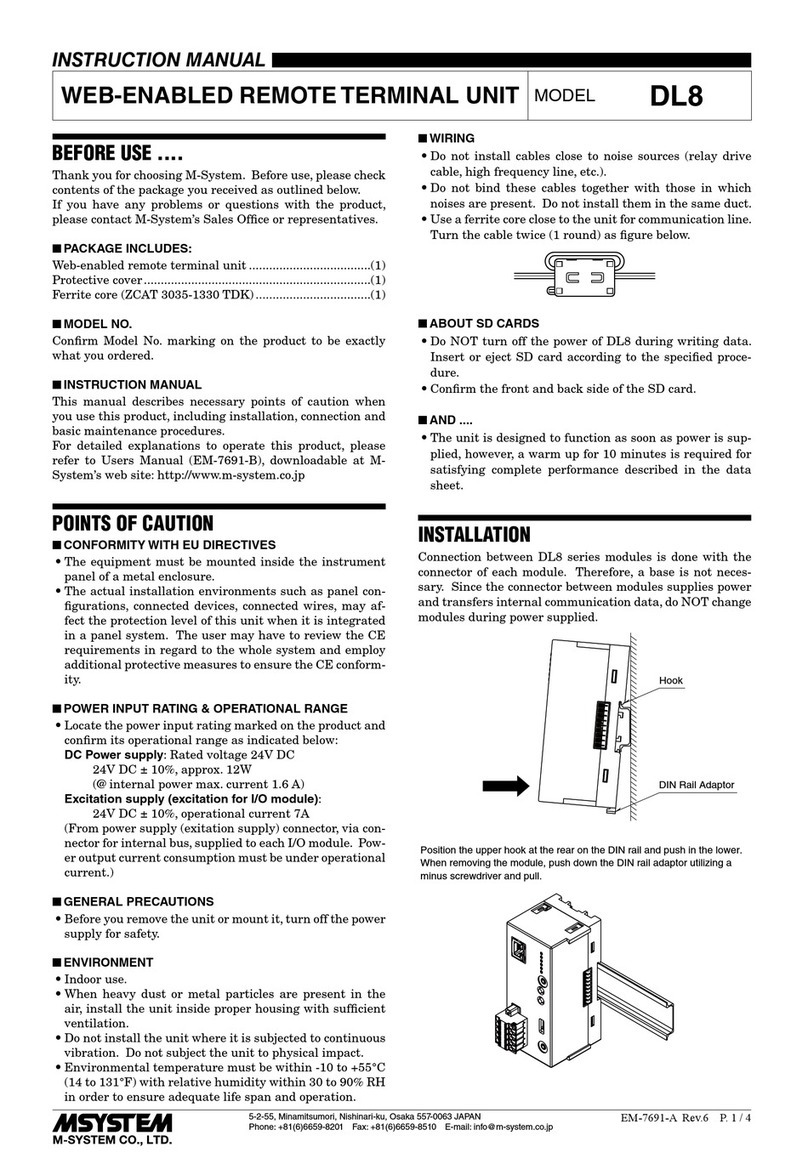NexSens Technology CB-50 User manual

CB-50 Data Buoy
User Guide
Last Revision: 20 October 2022
Date Generated: 9 December 2022
Copyright © 2022 NexSens Technology, Inc.

Table of Contents
1. General
CB-50 Data Buoy Overview
Key Components and Definitions
Key Specifications
CB-Series Data Buoy Planning & Precautions
2. Buoy Assembly
X2-SDL Submersible Data Logger Installation
M550 Beacon for CB-Series Data Buoys
Installation
Operation
CB-Series Data Buoy Instrument Cage Installation
CB-CCA Anti-Rotation Collar
Use of Sacrificial Anodes on CB-Series Data Buoys
3. Deployment
CB-Series Data Buoy Ballast Weight & Stability
Top-Side Weight
Ballast Weight
Buoy Ballast Weights
Mooring Data Buoys
Buoy Ballast
Mooring Eye Lifting
Data Buoy Mooring Types
CB-Series Data Buoy Deployment Tips
NexSens CB-Series Data Buoys
Connecting Mooring Hardware
Deployment
Single-Point Mooring Deployment
Two-Point and Three-Point Mooring Deployment
Planning a Medium-Deep Water Mooring for Small Data Buoys
Mooring Line Length Calculation
Chains for Controlled Movement vs. Ballast Weight
System Maintenance
Mooring Hardware Materials
Deployment
4. Troubleshooting and Maintenance
General Data Buoy Maintenance
Install Batteries in the X2-SDL Data Logger
4
4
4
5
6
8
8
10
10
11
12
13
14
15
15
16
17
18
19
19
19
19
25
25
25
26
27
28
29
29
33
35
35
36
39
39
41
2

1. General
CB-50 Data Buoy Overview
The CB-50 Data Buoy is an ultra-portable real-time system for short-term or seasonal monitoring of
dredging projects, industrial spills, natural disasters, and other emergency response situations. It is
designed to accommodate the NexSens X2-SDL submersible data logger for quick deployment of real-
time monitoring with a range of compatible sensors.
Key Components and Definitions
Buoy Hull – Constructed of cross-linked polyethylene foam with a durable polymer outer layer and
rugged stainless steel frame providing a net buoyancy of 50 lb (23 kg).
Data Well – The center hole of the hull designed specifically to accommodate the X2-SDL submersible
data logger.
Tower – The top of the CB-50 is covered with a removable foam tower with top plate which is secured
by a set of three eye nuts. This protects the X2-SDL logger while still allowing for wireless transmission,
and the top plate allows for mounting of topside instruments like the M550 solar marine light for
nighttime visibility.
Buoy Frame – The skeleton of the buoy is comprised of 316 stainless steel with three topside lifting
eyes and one subsurface mooring eye for single-point moorings. The frame supports attachment of an
optional instrument cage for secure connection of subsurface sensors, battery packs and additional
ballast weight for stability.
CB-50 data buoy.
4

Key Specifications
The key specifications of the CB-50 buoy are given below:
Hull Outer Diameter: 20.0” (50.8cm)
Hull Height: 12.0” (30.48cm)
Center Hole Inner Diameter: 5.5” (13.97cm)
Tower Height: 10.0″ (25.4cm)
Weight: 35 lb (16kg)
Net Buoyancy: 50 lb (23kg)
Hull Material: Cross-linked polyethylene foam with polyurea coating & stainless steel deck
Hardware Material: 316 stainless steel
Mooring Attachments: 1x 3/4” eye nut
CB-50 tower with solar
marine light.
X2-SDL mounted in CB-
50 data well.
CB-50 with X2-SDL
logger.
CB-50 buoy frame
(without cage).
5

CB-Series Data Buoy Planning & Precautions
Buoy deployments are usually complex operations that involve many elements including sensors, data
loggers, mounting hardware and mooring equipment. Careful planning is essential to the success of a
buoy project, not only for system operation and data collection but also to ensure the project personnel’s
safety and minimize the risk of damage to expensive system components. When planning a buoy
deployment, be sure to give careful consideration to the following aspects:
Buoy sizing and power budget – Buoys come in various physical sizes with differing batteries and
solar charging capacities. A buoy must be adequately sized to tolerate the site environmental conditions
while providing sufficient power for continuous system operation. A power budget should be calculated
to ensure the system can meet the demand for sensor measurements and data transmission.
Buoy ballast – Proper ballast of a buoy is critical to buoy stability when it is deployed in the water. Be
sure to review the ballast weight and stability guide when designing a buoy system. Some
experimentation may be required before final deployment.
Buoy mooring – Mooring systems come in many forms depending on the location, water depth, and
environmental conditions to which a buoy will be exposed. As a starting point, the mooring data buoys
guide provides an overview of common mooring strategies. However, NexSens does not endorse any
particular mooring strategy, and systems should be designed and executed based on careful
consideration and local knowledge of the deployment site.
Electrical connections – Many NexSens buoy systems utilize UW connectors for connection of power
and sensor cables. Data loggers such as the X2-CB have UW receptacle ports to receive sensor cables
fitted with UW plug connectors. UW connectors provide a double O-ring seal, with one O-ring inside the
receptacle and one around the plug. In order to ensure waterproof connection, check the following each
time a UW connection is made:
1. The O-ring inside the receptacle is present (has not fallen out)
2. The receptacle and plug are clean, dry and free of debris
3. The O-ring on the plug is lightly greased
4. Connection is tight, secure and fully seated
5. Unused receptacle ports are fitted with UW port plugs
Connections may be periodically inspected and maintained with O-ring grease, at a minimum before
each buoy deployment.
CB-Series data buoys contain a waterproof data well constructed of stainless steel where batteries are
mounted. Whenever installing or maintaining battery systems, use caution to avoid short-circuiting of
battery poles to the metal walls of the data well. Gloves and tools with rubber grips are recommended,
and any exposed connections should always be covered with electrical tape or other suitable coverings.
Safe deployment – Above all else, safety is the most critical consideration to take during the planning of
a buoy deployment. Any time a buoy system is deployed, there are countless hazards, including, but not
6

limited to, working on/near water and lifting of heavy equipment. Important factors to consider for
personnel safety are:
Use of safety equipment (i.e., life jackets, gloves, steel toed boots, etc.,)
Proper lifting and mooring techniques
Awareness of on-site and surrounding weather conditions and advisories
Despite careful planning, unforeseen situations are always still a possibility. Buoy deployments are an
at-risk operation, and the user assumes liability for any injury or damages that may occur.
7

2. Buoy Assembly
X2-SDL Submersible Data Logger Installation
The CB-50 data buoy is designed to securely hold the X2-SDL submersible data logger in the center
hole of the buoy. Reference the X2-SDL user guide for logger operation instructions.
IMPORTANT – BEFORE FIELD DEPLOYMENT: Completely configure and test the internal logging and
telemetry of sensors and data logger. Confirm that the batteries will provide adequate power for the
duration of the deployment. Ensure that all external sensor ports and battery compartments have a
watertight seal.
1. Loosen and remove the three top-facing eye nuts and threaded rod assemblies.
a. Remove the top white plate.
2. Lift the top foam tower off of the buoy base.
Remove the top white plate.
Remove the top foam tower.
8

3. Remove the orange exterior O-ring from the bottom of the X2-SDL.
a. Insert the X2-SDL into the buoy hull.
b. Push down until the top exterior orange O-ring rests against the steel plate.
4. Re-install the foam top and white plate.
a. Secure them in place by inserting and tightening the three top-facing threaded rod assemblies.
Insert the X2-SDL.
9

M550 Beacon for CB-Series Data Buoys
The NexSens M550 Solar Marine Light is a common accessory added to NexSens CB-Series data
buoys up to and including the CB-450. Depending on the configuration, it has a 1-3 nautical mile range
and is normally delivered with flange mount hardware, yellow color and default 15 flash/minute pattern
(Model M550-F-Y).
Installation
While it typically comes pre-installed, the M550 can easily be removed and/or installed by the user.
Reference the M550 Installation Instructions for guidance with the standard flange mount version. The
pole mount option can be similarly fixed to the buoy top plate using the provided hardware and one of
the pre-drilled holes on the top plate.
M550 Solar Marine Light.
M550 pole mount option. Mounted to top plate.
10

CB-Series Data Buoy Instrument Cage Installation
The instrument cage attaches to the bottom of CB-Series buoys for water sensor deployments while
simultaneously lowering the center of gravity and increasing stability.
Model number CAGE is 39″ (99 cm) in length and is normally used with the CB-50, CB-150, CB-250 and
CB-450 buoys. It is an optional accessory for the CB-50 and comes standard with the others.
Model number CAGE-L is 44″ (112 cm) in length and has a wider profile. It comes standard with CB-
650, CB-950 and CB-1250 buoys.
The cage is a critical component of the ballast weight of a data buoy and provides a mounting location
for additional ballast weight to be added as needed.
Attachment to the internal frame of a data buoy is simple using the provided hardware.
1. Use the provided bolt, lock washer and castle nut to attach the cage to the buoy frame.
Model CAGE instrument cage. Model CAGE-L instrument cage.
Bolt installation and cage connection.
12

2. Tighten firmly with a pair of 1-1/8” wrenches such that the lock washer is flattened and the bolt hole
is aligned with a notch on the castle nut.
3. Place the cotter pin through the bolt hole and bend the long leg of the pin.
CB-CCA Anti-Rotation Collar
The single bolt connection is sufficient for small buoys in calm waters. However, a CB-CCA Buoy Cage
Anti-Rotation Collar may be used for added security in rough waters or when suspending sensor strings
from the cage. It is included standard and should always be used with buoy models CB-650 and larger
that come with the CAGE-L. For installation instructions, see the CB-CCA installation guide.
Secured cage.
Cotter pin with bent leg for security.
CB-CCA collar.
13

Use of Sacrificial Anodes on CB-Series Data Buoys
Sacrificial zinc anodes are recommended for use on CB-Series data buoys any time they will be used in
saltwater environments. This helps to prevent corrosion on the stainless steel frame, as zinc is a more
active metal that will be consumed while protecting the stainless steel.
Anodes sourced from NexSens are sized specifically for installation onto buoy frames and instrument
cages using a pair of screws provided with the anode. They will typically need to be replaced
approximately every 6 months, though this may vary depending on factors such as the temperature and
salinity of the saltwater environment. Buoys should be regularly inspected and anodes replaced any
time it appears they will be consumed before the next scheduled maintenance. It is often a good idea to
have two anodes installed onto a buoy – one on the frame and one on the cage – and replace them
intermittently to ensure that there is always sufficient protection for the stainless steel. Anode
replacement will require a 4-mm Allen wrench to remove the pair of screws connecting the two anode
halves.
Zinc is chosen for the anode material because it is a readily-available metal with a lower reduction
potential (-0.76V) than the steel of the buoy frame. This offers the steel what is known as cathodic
protection, where oxidation reactions are transferred away from the steel to the zinc when placed in
highly ionic environments such as saltwater in the case of a buoy. The zinc is slowly consumed by the
process, hence the term sacrificial anode.
In theory, other materials besides zinc can be used as the anode as long as they rank lower on the
reduction potential scale than the stainless steel. Generally speaking, the larger the difference between
the metals on the scale, the faster the rate of the oxidation-reduction reaction. Materials with lower
reduction potential than zinc may therefore be consumed more rapidly and require more frequent
changes. Regardless of anode material chosen, frequent inspection and replacement of anodes as
needed can extend the life of a data buoy significantly in saltwater.
Sacrificial anodes are normally not necessary for buoys used in freshwater except in special
circumstances. It is therefore generally recommended only to order anodes with buoys intended for use
in brackish or saltwater.
Sacrificial zinc anodes.
14

3. Deployment
CB-Series Data Buoy Ballast Weight & Stability
Ballast weight may be needed to prevent overturning a CB-series buoy system and ensure stability in
the water. The center of gravity of NexSens CB-Series buoys is near the water surface without
instruments connected. Therefore, any top-side weight added above the water’s surface (e.g., sensors,
sensor mounts) must be appropriately counterbalanced by ballast weight below the surface (e.g.,
instrument cage, chain, anchors, etc.). Before deploying a buoy system, some experimentation may be
required to balance the system properly.
Figure 1: NexSens CB-450 buoyancy diagram.
15

Top-Side Weight
Top-side weight is any weight mounted on the buoy above the water surface or the buoys’ center of
gravity. Top-side weight located further from the buoys’ center of gravity will cause greater instability of
the buoy. For example, suppose a weather sensor is mounted 36″ above the water surface (Figure 2). In
that instance, the sensor mount will cause more buoy instability than mounted 24″ above the
surface (Figure 3). As a result, the buoy would require more subsurface ballast weight to
counterbalance.
Figure 2: Top-side weight mounted higher
causes greater buoy instability.
Figure 3: Top-side weight mounted closer to the water
surface provides more stability.
16

Ballast Weight
Ballast weight is any weight mounted on the buoy below the water surface or the buoys’ center of
gravity. Contrary to top-side weight, a ballast weight added further below the surface (Figure 4) will
provide a more significant stabilizing effect than the same size weight mounted closer to the
surface (Figure 5). An instrument cage mounted to the buoy frame helps stabilize the buoy and provides
a deeper location for mounting additional weight. For single-point mooring configurations, mooring
chains and lines connected to the bottom of the cage may provide adequate ballast. For multi-point
configurations, the mooring hardware does not contribute to the ballast weight. If needed, add ½ inch
galvanized chain (~2.3lb/ft) to the bottom of the cage, or utilize NexSens 25lb. ballast weight that can be
added to the cage in specific applications.
NexSens CB-series buoy data wells are not rated for submersion, so proper ballast weight is critical to
ensure that the buoy does not overturn, including when subjected to additional loading (e.g., high
wind/waves, periodic snow/ice loads, etc.).
For information on NexSens CB-Series buoy ballast weight recommendations, follow the link below.
NexSens CB-Series Buoy Ballast Weights
Figure 4: Ballast weight mounted deeper below the
surface provides greater buoy stability.
Figure 5: Ballast weight mounted closer to the surface
causes greater buoy instability.
17

Buoy Ballast Weights
The table below indicates the minimum recommended ballast weight for each CB-Series data buoy,
assuming no additional topside weight and calm environmental conditions. Included instrument cages
mounted to the buoy frame helps stabilize the buoy and provides a deeper location for mounting
additional weight. The small model instrument cage (10 lbs.) is included with the purchase of CB-150,
CB-250, & CB-450 buoy models and is an optional purchase for the CB-50. The large model instrument
cage (26 lbs.) is included with the purchase of CB-650, CB-950, & CB-1250 buoy models. Typically, no
additional ballast weight is necessary for the CB-25-SVS, CB-25, & CB-40 models as each buoy comes
standard with either 1/2″ galvanized chain (CB-25 & CB-25-SVS) or an installed steel instrument pipe
(CB-40) for ballast.
Model Buoyancy (lbs.) Minimum Recommended
Ballast Weight (lbs.)1
CB-25-SVS 25 —
CB-25 25 —
CB-40 40 —
CB-50 50 —
CB-150 150 —
CB-250 250 —
CB-450 450 —
CB-650 650 50
CB-950 950 100
CB-1250 1250 150
1Minimum recommended ballast weight incorporates the weight of the included or optionally purchased instrument cage.
Important: To effectively provide adequate ballast weight, a variety of application-specific criteria
(sensor weight and positioning, water level fluctuations, wave and current action, external loading, etc.)
must be thoroughly reviewed prior to deployment. NexSens does not endorse using these specific
ballast weights for all applications.
For more information regarding buoy ballast weight and stability, please refer to the following article:
CB-Series Data Buoy Ballast Weight & Stability
18

Mooring Data Buoys
This article contains only general information on the available mooring options for NexSens data buoys.
Developing an effective mooring strategy requires reviewing various application-specific criteria (water
level fluctuations, currents and wave action, debris loads, etc.) before deployment. This document is
intended to provide a starting place for mooring design and is by no means comprehensive. Good
mooring design is often developed through years of experience with various deployment scenarios. For
first-time mooring designers, it is best to include an experienced marine engineer.
NexSens Technology supplies mooring hardware to support user-designed systems but does
not endorse any particular mooring strategy for any specific application and does not take
responsibility for mooring performance or damage resulting from mooring failure.
Buoy Ballast
Buoy ballast is best handled by adding weight to the bottom of the buoy and not relying on the mooring
weight to act as ballast. Additionally, the weight associated with biofouling growth can impact the buoy
buoyancy and mooring performance. Minimum recommended ballast weights for NexSens Technology
data buoys can be reviewed at the link below.
NexSens Technology Buoy Ballast Weights
More information on buoy ballast can also be found at the link below.
CB-Series Data Buoy Ballast Weight & Stability
Mooring Eye Lifting
All NexSens CB-Series buoy models have three topside mooring eyes located around the solar tower.
These are sufficiently strong that a buoy can be lifted from a single top-facing eye nut via crane or winch
for removal or deployment when required. Care should always be taken to avoid damaging any solar
panels, topside sensor mounts and sensors connected to the instrument cage when lifting and moving a
buoy.
Data Buoy Mooring Types
There are three commonly used mooring types for data buoy applications:
1. Catenary moorings
2. Semi-taut two point moorings
3. Inverse-catenary (S-shape) moorings
19

1. Catenary Moorings
For shallow deployments with minimal wind, wave and current loading, most data buoys utilize catenary
moorings. Shallow deployments can be designed with all chain or a combination of heavy bottom chain
and light water column chain. Deeper water moorings may need to use a combination of chain and rope.
Example catenary mooring deployment with single
chain for shallow waters.
Example catenary mooring with combination of rope
and chain for deeper waters.
20
Table of contents
Other NexSens Technology Data Logger manuals
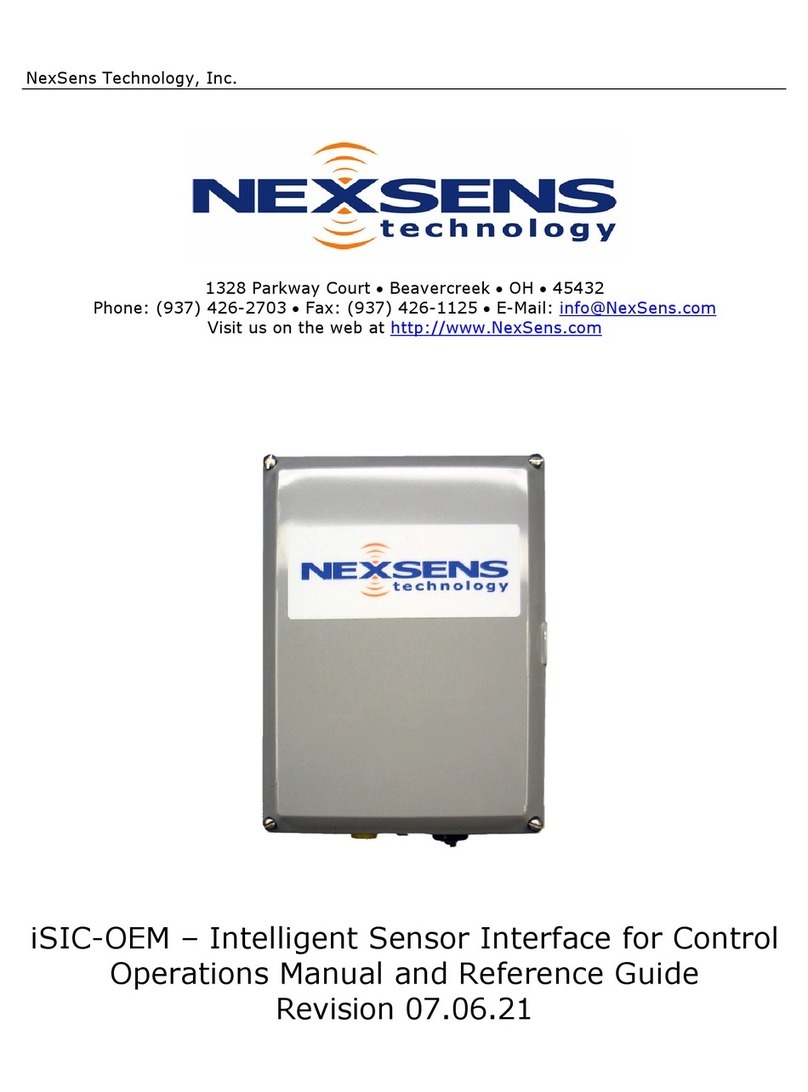
NexSens Technology
NexSens Technology iSIC-OEM User manual

NexSens Technology
NexSens Technology CB-450 User manual
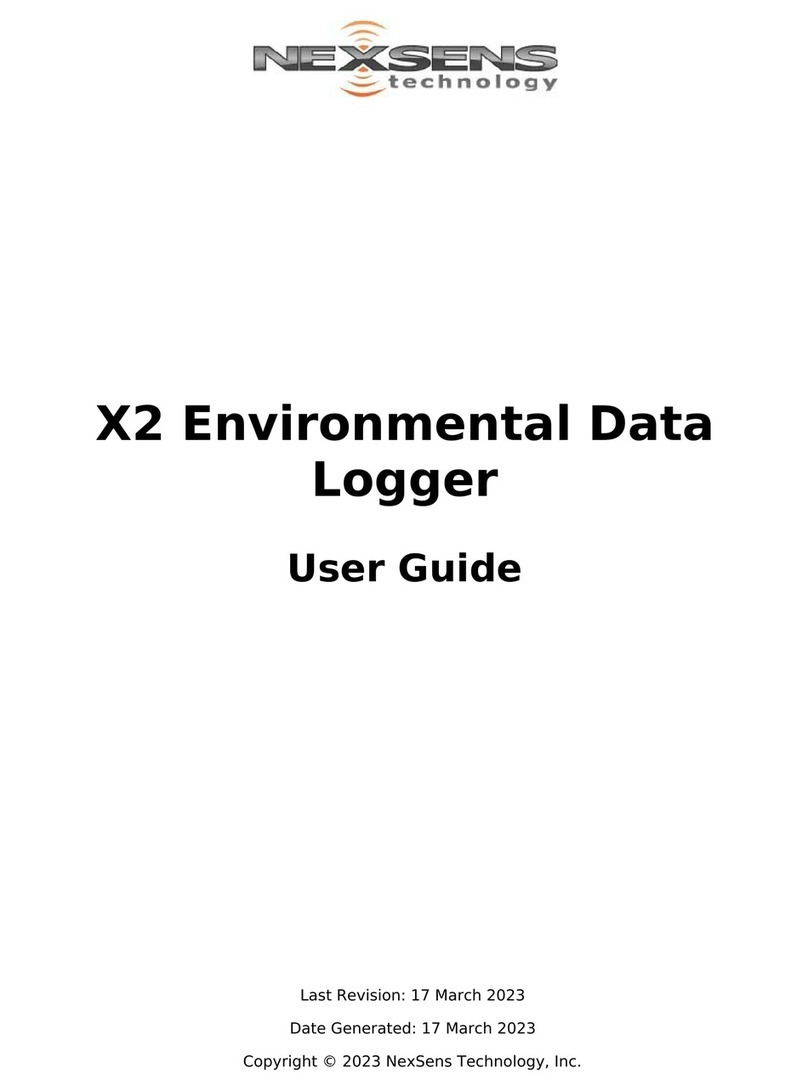
NexSens Technology
NexSens Technology X2 User manual

NexSens Technology
NexSens Technology CB-250 User manual
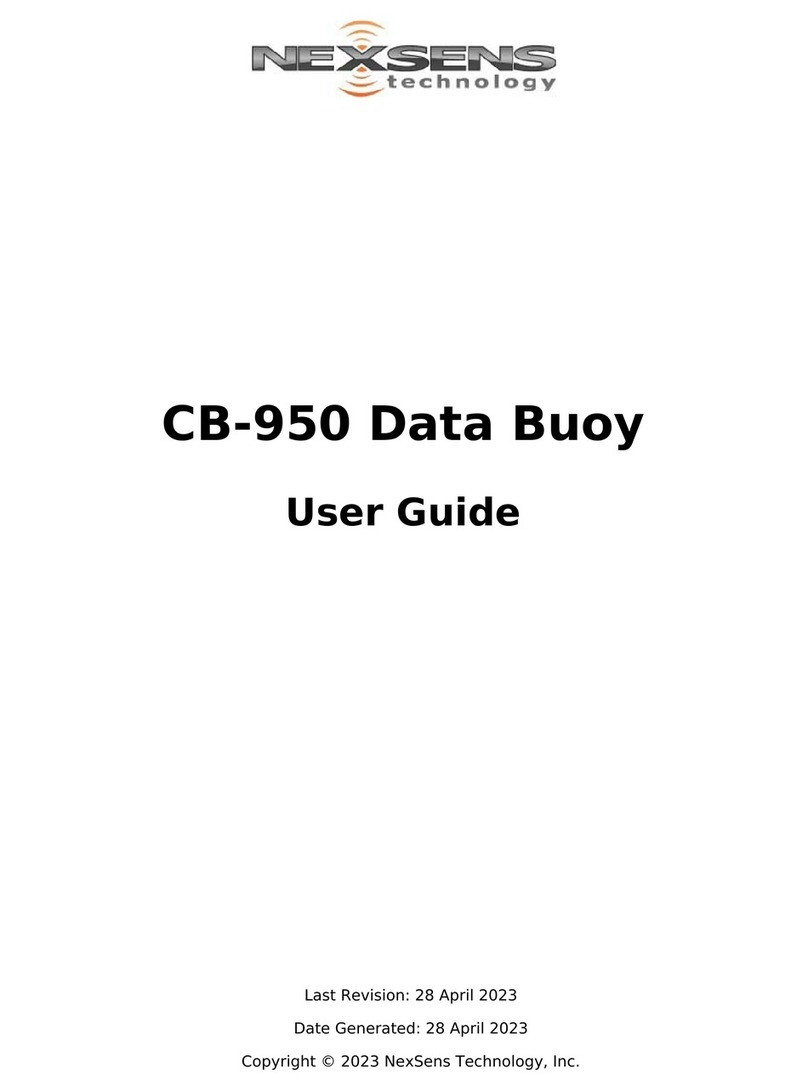
NexSens Technology
NexSens Technology CB-950 User manual
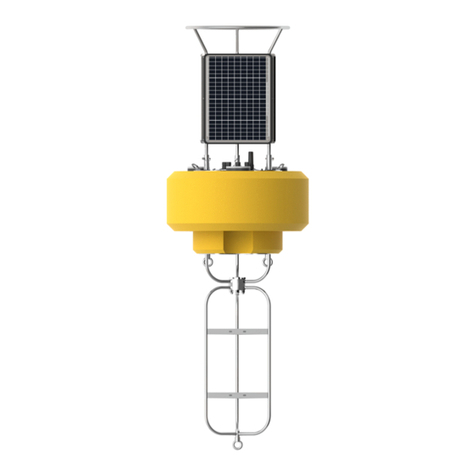
NexSens Technology
NexSens Technology CB-650 User manual
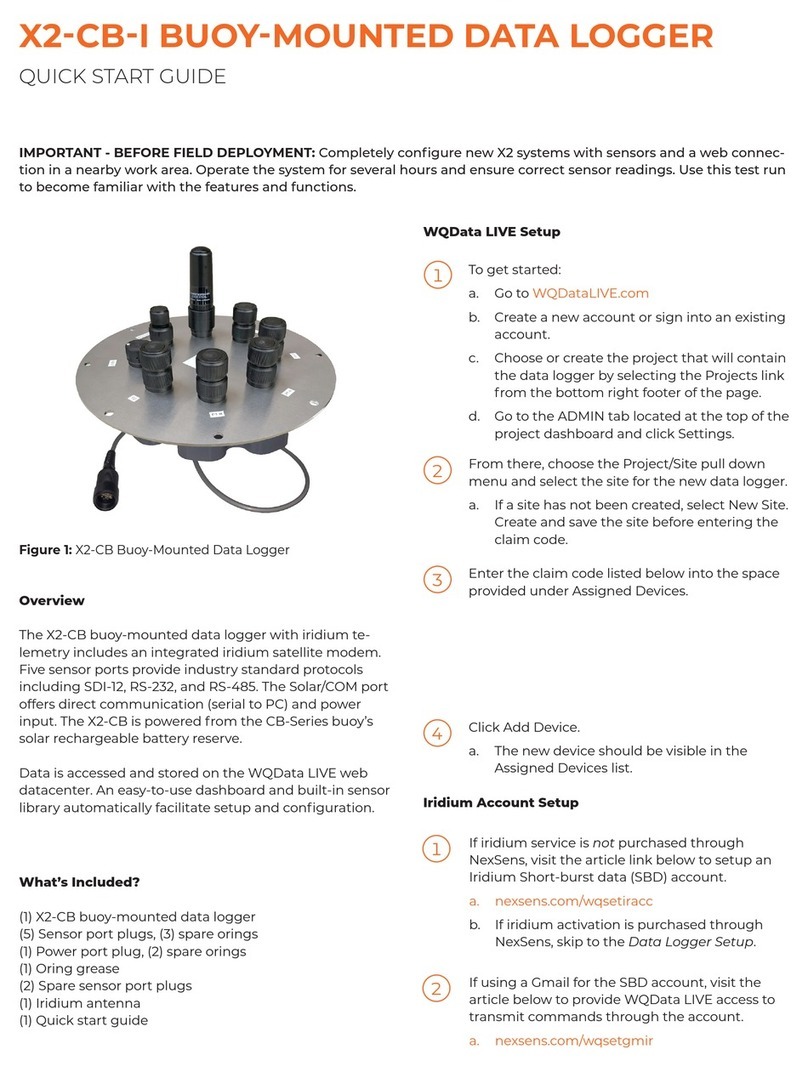
NexSens Technology
NexSens Technology X2-CB-I User manual
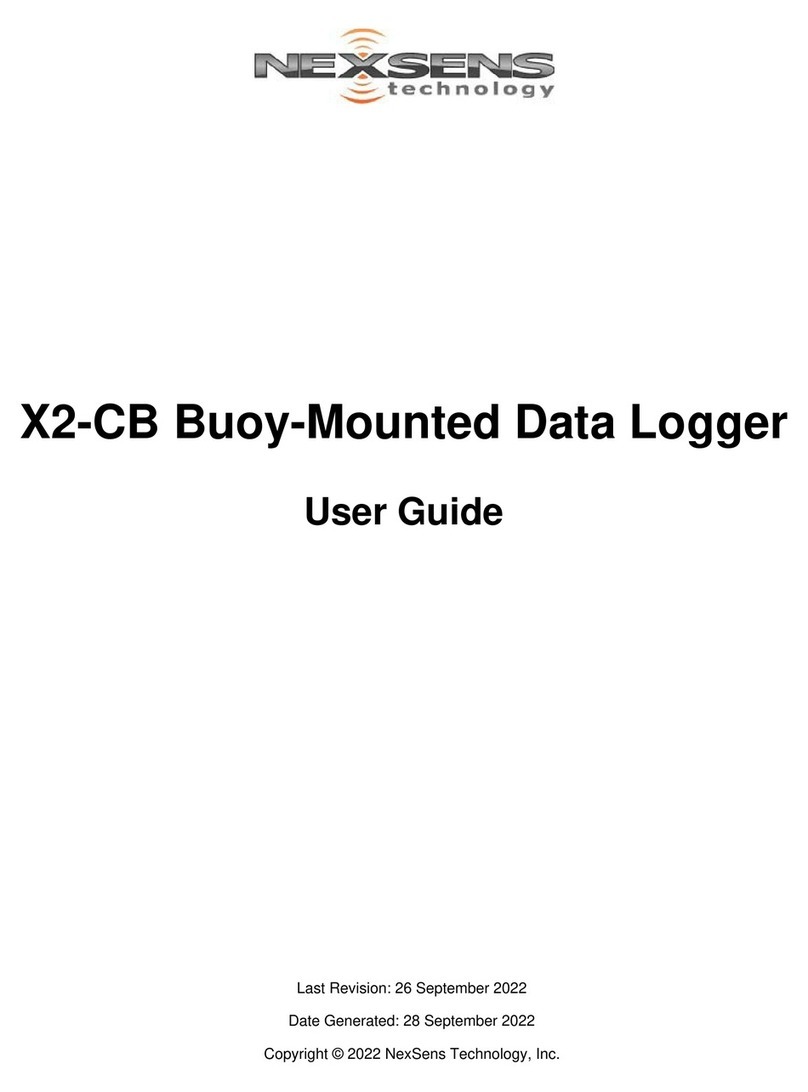
NexSens Technology
NexSens Technology X2-CB User manual
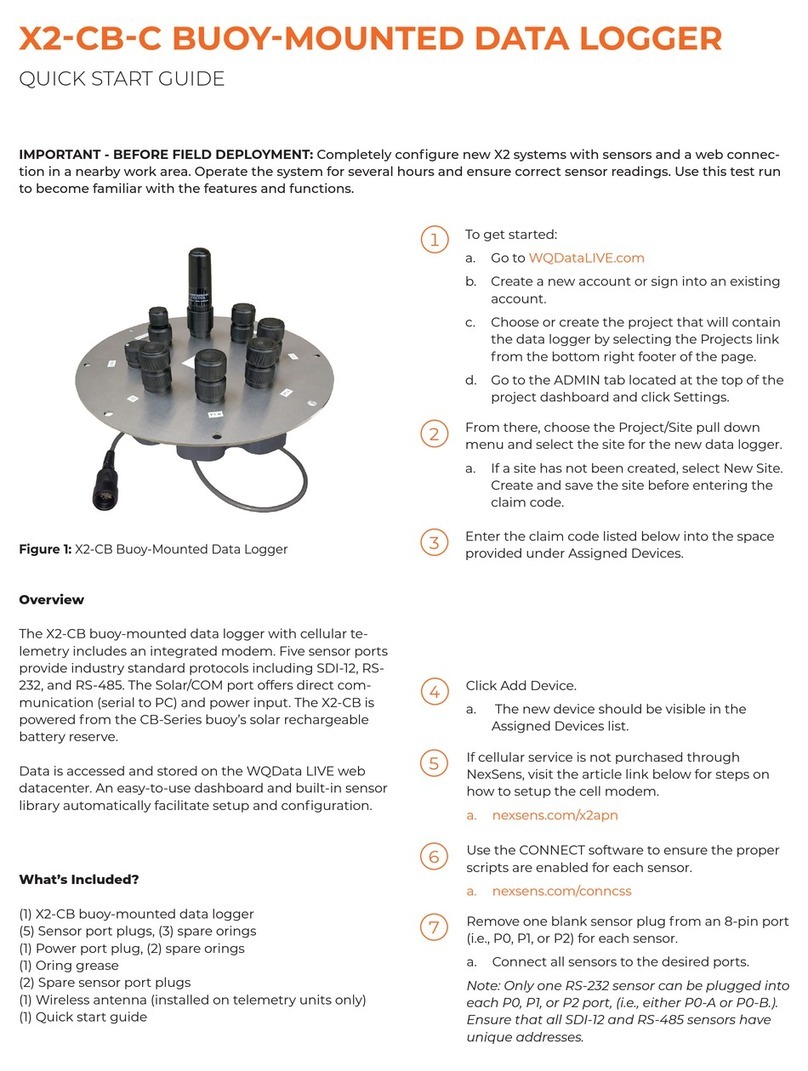
NexSens Technology
NexSens Technology X2-CB-C User manual
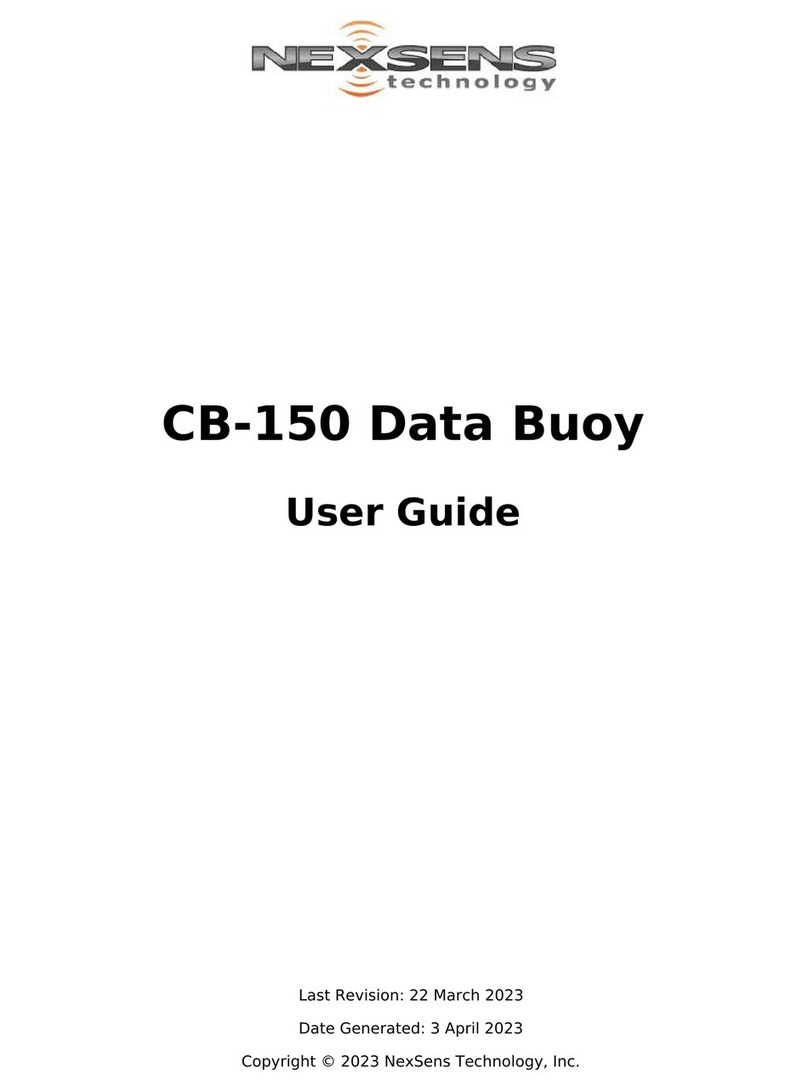
NexSens Technology
NexSens Technology CB-150 User manual


